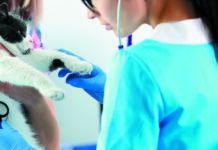If your typically playful cat suddenly becomes lethargic and suffers frequent bouts of sneezing and sniffling, there’s a good chance that she’s come down with what might be called “a bad cold.”
If that’s the case, it’s quite possible that the cause of her discomfort is infection with the feline calicivirus (FCV), which is diagnosed in an estimated 40 to 50 percent of cats with upper respiratory illness. (Most other occurrences of such disorders in cats are caused by infection with a different virus — herpesvirus — or with a bacterial agent or other microorganism.)
FCV, like all other viruses, is not a living organism. Rather, it may be described in general terms as a complex submicroscopic structure consisting of genetic material that is encased in a protein shell.
Also like other viruses, FCV has an irrepressible inclination to reproduce itself rapidly and without limitation in the body of an animal that it has infected. And once the virus has entered the host’s body, its fundamental goal is to make as many copies of itself as rapidly as possible. This gradually overwhelming proliferation of the viral particles produces the clinical signs signaling FCV’s presence.
Early signs to observe
The initial signs that a cat has been infected with FCV are those typically associated with an upper respiratory infection, says Orla Mahony, MVB, a specialist in endocrinology at the Foster Hospital for Small Animals. “These early signs, which include, for example, sneezing, nasal and ocular discharge, and loss of appetite, tend to be mild and transitory, with discomfort primarily involving the respiratory system.”
But the persistent presence of FCV in a cat’s system, she points out, can progress to cause a variety of other problems, such as inflammation of tissues in the affected animal’s eyes, open sores on the tongue or elsewhere within the oral cavity, and even lameness.
Although the initial signs of FCV infection will typically diminish in severity within a few days, veterinary consultation should nevertheless be pursued as soon as any of the telltale clinical signs are noted.
How a cat becomes infected
In order to be infected with FCV, a cat has to somehow come into direct contact with the virus, which is present in an infected animal’s saliva and nasal and eye discharges. FCV can also be spread by inhalation, explains Dr. Mahony. If, for instance, an infected cat sneezes, viral particles can be sprayed several yards through the air and inhaled by an uninfected cat. And because the virus is frequently transmitted through licking, a kitten can become infected while being groomed by her FCV-infected mother.
Moreover, notes Dr. Mahony, viral particles can survive for a month or more at room temperature in the external environment; they can therefore persist on the surfaces of such objects as litter boxes, food dishes, and even an owner’s clothing.
“After visiting a shelter or a friend with a sick cat,” says Dr. Mahony, “you can bring the virus home with you on your clothing or shoes and give it to your cat.” The spread of this virus can be an especially serious problem in crowded shelters, she adds, where infected and uninfected cats are housed in close contact.
Most of the initial indications that a cat has been infected with FCV — the persistent sneezing, ocular discharge, occasional coughing — will manifest themselves within a week or so following exposure to the virus. In the best case scenario, the signs of infection will be mild, and an FCV-infected cat will not even run a slight fever. The infection will run its course.
Supportive care is common
“Fortunately, the immune system will fight off the infection typically within a week or two. Most cats are usually feeling better within five or six days,” says Dr. Mahony. “So treatment is usually supportive. If the cat isn’t eating, her nose may be all stuffed up, so you might try to coax her with warmed, tasty food, and keep her nose wiped clean. You just want to try to keep her as comfortable and well nourished as possible.”
In some cases, unfortunately, an affected cat will run a high fever, and oral ulcerations will start to appear. Because of these sores, the animal’s mouth may hurt when she tries to eat or drink, so the animal can become dehydrated and lose weight. The cat may require intravenous fluids and, in some cases, the veterinarian may have to install a feeding tube in the animal’s esophagus to help it to eat. This will keep the cat nourished while the infection is clearing up.
In general, kittens are especially vulnerable to infection with the most common strains of FCV. Also at elevated risk are cats of all ages whose immune systems have been weakened as the result of infections with other viral diseases, such as those caused by the feline immunodeficiency virus (FIV) or the feline leukemia virus (FeLV).
Adult cats, meanwhile, are more likely than young cats to be affected by a different and more dangerous type of the calicivirus, called virulent systemic feline calicivirus (VS-FCV). “Picking up that strain of the virus is the worst-case scenario,” says Dr. Mahony.
“Cases have been reported in which adult cats have the hallmark oral ulcers accompanied by swelling of the face and limbs, frequently progressing to multi-organ failure and death. The mortality rate for this disorder is as high as 70 percent. Fortunately, we don’t see anything like that most of the time.” Keep in mind, advises Dr. Mahony, that the signs of calicivirus infection include nasal discharge due to chronic rhinitis; and a painfully inflamed mouth due to stomatitic gingivitis.
Vaccination works well
The best protection against FCV infection, she points out, is vaccination. The vaccine that is currently used is excellent, which is why veterinarians consider it to be a “core” vaccine.
The American Association of Feline Practitioners and other veterinary organizations currently recommend that kittens should be vaccinated to protect against FCV infection when they are eight to 10 weeks of age and three or four weeks thereafter until the animal is at least 20 weeks of age.
In addition, a cat should receive subsequent booster shots in a year and again every three years thereafter. — Tom Ewing



